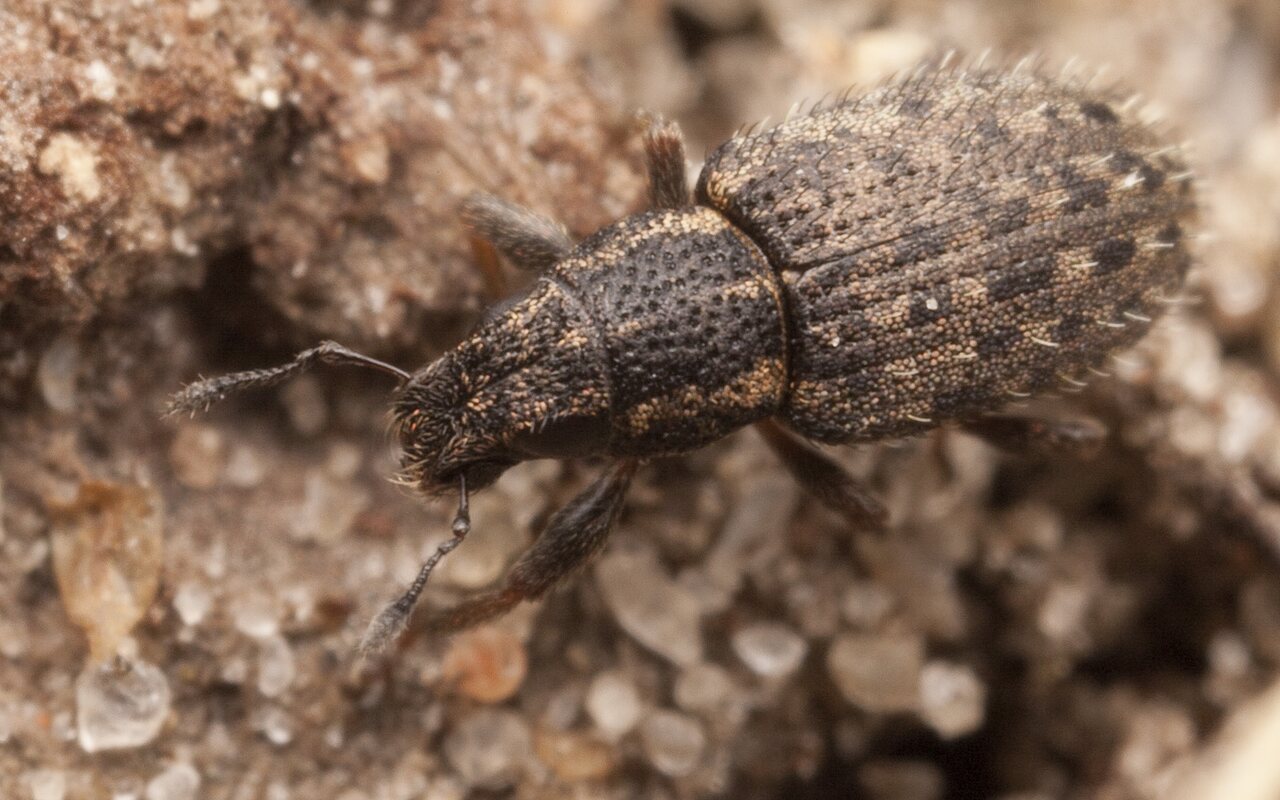
Sitona hispidulus · sitonas
- clover weevil, Clover-Root Weevil, Clover Root Curculio
- Borstiger Blattrandrüssler
- Kløverbladrandbille
- oprzędzik żółtonogi
- borstig ärtvivel
Common and often abundant throughout most of the Palaearctic region from Portugal to the far east of Russia and Japan, in Europe it extends north into the UK and southern provinces of Fennoscandia and east through the Balkans and Asia Minor, it occurs on the Atlantic Islands and most of the Mediterranean islands and is known from North west Africa. It was discovered in North America in New Jersey in 1875, presumably from imported European specimens, and is now widespread and established from Mexico to southern and eastern parts of Canada.
Adults occur year-round; they overwinter in tussocks or among litter although at this time they are often active in all but the coldest weather, and are active over a long season from March until November, peaking in abundance during September and October. Overwintered adults begin feeding as soon as they emerge, the majority remaining close to where they developed, they produce irregular or U-shaped indentations in host foliage which may become very conspicuous among large infestations but which does not seriously damage the plants. Host plants include a wide range of legumes, they may become serious pests of crops such as Lucerne (Medicago sativa L.) or various commercially grown cultivars of clover but more generally they occur on a range of wild clovers (Trifolium L.) and vetches (Vicia L.), and have been recorded attacking peas grown in domestic gardens. Reproduction occurs in the spring after a period of feeding although it is likely that, at least in some areas, this also occurs in the autumn as eggs have been observed to overwinter, larvae on the other hand cannot survive the winter. Oviposition begins in May or June and may continue over a long season as adults are known to live for about a year and those that eclose late in the season may continue to oviposit well into the autumn. Eggs are deposited in small batches in the soil beneath suitable host plants and larvae emerge within a week or two, as first instars they feed on root nodules but second and third instars bore holes and galleries into roots, weakening larger roots and often severing smaller roots completely. Pupation begins towards the end of summer and adults are fully formed within about two weeks, they generally remain in situ but are stimulated to emerge and feed by lower temperatures, at this time adult populations peak and damage to foliage may become extensive before the weevils return to the soil or litter to overwinter. Larval feeding can seriously damage commercially grown legumes, both by direct physical damage and by introducing secondary pathogens.
3.0-4.6 mm. Broadly-oval with a large head and broadly rounded shoulders, body black, usually with a distinctive pattern of oval brown, creamy and white scales which often form longitudinal stripes on the head and pronotum and a variegated or random pattern on the elytra, legs reddish with darker femora, antennae dark reddish-brown. Head with weakly convex, almost flat eyes and short temples, vertex and frons weakly concave, rostrum broad and almost quadrate, with a median impression that extends to the posterior margin of the eyes but lacking dorso-lateral impressions, scrobes lateral, down curved and only very narrowly visible from above. Antennal scape short, about as long as the width of the rostral base, and thickened just before the apex, basal funicular segments elongate, apical segments quadrate or nearly so, club long and pointed. Pronotum quadrate or very slightly transverse, broadest about the middle and evenly curved to distinct angles, surface strongly but not densely punctured. Elytra parallel-sided or slightly dilated from broadly-rounded shoulders to a continuous apical margin, striae strongly punctured but not impressed, interstices flat and in placed densely scaled, towards the base and apex with long erect protective setae that usually form distinct lines. Legs long and robust, femora not toothed, tibiae hardly broadened from the base, tarsi pseudotetramerous with claws separate to the base.
‥
0 comments
Add a comment
Comments